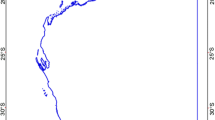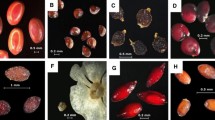Abstract
Red-osier dogwood (Cornus sericea L.) seedlings from three seed sources of different climatic conditions were treated hydroponically with 0–100 mM NaCl to compare their salinity tolerance. The control seedlings from the coldest location, Alberta (AB) had the lowest biomass and transpiration rate, as well as the highest photosynthetic water use efficiency. When exposed to 100 mM NaCl for 1 week, the seedlings from AB maintained a higher photosynthetic rate and stomatal conductance than the seedlings from the low precipitation location, British Columbia (BC), and the high precipitation location, New Brunswick (NB). After 2 weeks of treatment at this highest salt concentration, leaf injury occurred in the plants from all the locations suggesting that in spite of early differences, the seedlings from all locations may not be able to survive the salinity stress over time. In contrast, when plants were exposed to 50 mM NaCl, the seedlings from AB had low level of leaf injury, followed by the plants from BC compared with the NB seedlings. Furthermore, at this moderate salt concentration, the seedlings from NB (with the highest biomass for the control) had the lowest root relative growth rate and the highest leaf area; while the seedlings from AB and BC had the highest photosynthetic water use efficiency. The seedlings from AB were able to retain more K in the roots than the seedlings from NB, suggesting a higher level of salinity tolerance. Lower chloride content was observed in the leaves of the AB seedlings than in the BC seedlings. The results of this study show that when exposed to 50 mM NaCl, the seedlings from the cold (AB) and dry (BC) locations had higher salt tolerance than the seedlings from the milder climate (NB). These results suggest that cross tolerance may occur in red-osier dogwood; however, it varies depending on the level of salinity stress.





Similar content being viewed by others
References
Appleton B, Greene V, Smith A, Roads H, French S (2003) Trees and shrubs that tolerate saline soils and salt spray drift. Virginia Cooperative Extension. Publication number 430-031. Available from http://www.ext.vt.edu/pubs/trees/430-031/430-031.html. Accessed in October 2003
Ashworth EN, Stirm VE, Volenec JJ (1993) Seasonal variations in soluble sugars and starch within woody stems of Cornus sericea L. Tree Physiol 13:379–388
Blumwald E, Aharon GS, Apse MP (2000) Sodium transport in plant cells. Biochim Biophys Acta 1465:140–151. doi:10.1016/S0005-2736(00)00135-8
Bray EA, Parsons LR (1981) Clonal variations in the water relations of red-osier dogwood during cold acclimation. Can J Plant Sci 61:351–363
Carter CT, Grieve CM, Poss JA, Suarez DL (2005) Production and ion uptake of Celosia argentea irrigated with saline wastewaters. Sci Hort 106:381–394. doi:10.1016/j.scienta.2005.04.007
Cuin TA, Betts SA, Chalmandrier R, Shabala S (2008) A root’s ability to retain K+ correlates with salt tolerance in wheat. J Exp Bot 59:2697–2706
Downton WJS, Grant WJR, Robinson SP (1985) Photosynthetic and stomatal responses of spinach leaves to salt stress. Plant Physiol 77:85–88
Farooq S, Azam FE (2001) Co-existence of salt and drought tolerance in Triticeae. Hereditas 135:205–210
Franklin JA, Zwiazek JJ (2004) Ion uptake in Pinus Banksiana treated with sodium chloride and sodium sulfate. Physiol Plant 120:482–490. doi:10.1111/j.0031-9317.2004.00246.x
Genc Y, Mcdonald GK, Tester M (2007) Reassessment of tissue Na+ concentration as a criterion for salinity tolerance in bread wheat. Plant Cell Environ 30:1486–1498
Grattan SR, Grieve CM (1999) Salinity-mineral nutrient relations in horticultural crops. Sci Hort 78:127–157
Green S, Renault S (2008) Influence of papermill sludge on growth of Medicago sativa, Festuca rubra and Agropyron trachycaulum in gold mine tailings: a greenhouse study. Environ Pollut 151:524–531. doi:10.1016/j.envpol.2007.04.016
Greenway H, Munns R (1980) Mechanisms of salt tolerance in non-halophytes. Annu Rev Plant Physiol 31:149–190
Gutierrez Boem FH, Scheiner JD, Lavado RS (1994) Some effects of soil salinity on growth, development and yield of rapeseed (Brassica napus L.). J Agron Crop Sci 172:182–187
Kronzuker HJ, Szczerba MW, Schulze LM, Britto DT (2008) Non-reciprocal interactions between K+ and Na+ ions in barley (Hordeum vulgare L.). J Exp Bot 59:2793–2801
Lambers H, Chapin FS III, Pons TL et al (1998) Plant physiological ecology. Springer, NY, p 540
Maas EV (1993) Salinity and citriculture. Tree Physiol 12:196–216
Maathuis FJM (2006) The role of monovalent cation transporters in plant responses to salinity. J Exp Bot 57:1137–1147. doi:10.1093/jxb/erj001
Maathuis FJM, Amtmann A (1999) K+ nutrition and Na+ toxicity: the basis of cellular K+/Na+ ratios. Ann Bot 84:123–133
Marcar NE, Crawford DF, Saunders A, Matheson AC, Arnold RA (2002) Genetic variation among and within provenances and families of Eucalyptus grandis W. Hill and E. globulus Labill. subsp. globulus seedlings in response to salinity and waterlogging. Forest Ecol Mange 162:231–249
Marcelis LFM, Van Hooijdonk J (1999) Effect of salinity on growth, water use and nutrient use in radish (Raphanus sativus L.). Plant Soil 215:57–64
Megdiche W, Ben Amor N, Debez A, Hessini K, Ksouri R, Zuily-Fodil Y, Abdelly C et al (2007) Salt tolerance of the annual halophyte Cakile maritima as affected by the provenance and the developmental stage. Acta Physiol Plant 29:375–384
Mustard J, Renault S (2004) Effects of NaCl on water relations and cell wall elasticity and composition of red-osier dogwood (Cornus stolonifera) seedlings. Physiol Plant 121:265–271. doi:10.1111/j.1399-3054.2004.00322.x
Mckenzie RC, Najda, H.G (1994) Salinity tolerance of turf and forage grasses. Alberta Agriculture Research Institute Project # 92-0048F
Nguyen NT, Moghaieb REA, Saneoka H, Fujita K (2004) RAPD markers associated with salt tolerance in Acacia auriculiformis and Acacia mangium. Plant Sci 167:797–805
Pareek A, Sopory SK, Bohnert HJ, Govindjee (eds) (2010) Abiotic stress adaptation in plants. Physiological, Molecular and Genomic Foundation, 1st edn. Springer, Dordrecht
Prat D, Fathi-Ettai RA (1990) Variation in organic and mineral components in young Eucalyptus seedlings under saline stress. Physiol Plant 79:479–486
Purdy BG, Macdonald SE, Lieffers VJ (2005) Naturally saline boreal communities as models for reclamation of saline oil sand tailings. Restor Ecol 13:667–677
Renault S, Affifi M (2009) Improving NaCl resistance of red-osier dogwood: the role of CaCl2 and CaSO4. Plant Soil 315:123–133. doi:10.1007/s11104-008-9737-7
Renault S, Paton E, Nilsson G, Zwiazek JJ, MacKinnon MD (1999) Responses of boreal plants to high salinity oil sands tailings water. J Environ Qual 28:1957–1962
Renault S, Croser C, Franklin JA, Zwiazek JJ (2001) Effects of NaCl and Na2SO4 on red-osier dogwood (Cornus stolonifera Michx) seedlings. Plant Soil 233:261–268
Rengasamy P (2006) World salinization with emphasis on Australia. J Exp Bot 57:1017–1023. doi:10.1093/jxb/erj108
Rengel Z (1992) The role of calcium in salt toxicity. Plant Cell Environ 15:625–632
Ryu SB, Costa A, Xin ZG, Li PH (1995) Induction of cold hardiness by salt stress involves synthesis of cold responsive and abscisic acid responsive proteins in potato (Solanum commersonii Dun). Plant Cell Physiol 36:1245–1251
Sarnighausen E, Karlson D, Ashworth E (2002) Seasonal regulation of a 24-kDa protein from red-osier dogwood (Cornus sericea) xylem. Tree Physiol 22(6):423–430. doi:10.1093/treephys/22.6.423
Sarnighausen E, Karlson D, Zeng Y, Goldsbrough PB, Raghothama KG, Ashworth E (2004) Characterization of a novel YnSKn class of dehydrin-like cDNAs from cold acclimated red-osier dogwood (Cornus sericea L.) xylem. J Crop Improv 10:17–35
Smedema LK (1990) Irrigation performance and waterlogging and salinity. Irrig Drain Syst 4:367–374
Smithberg MH, Weiser CJ (1968) Patterns of variation among climatic races of red-osier dogwood. Ecology 49:495–505
Sun WQ (2002) Methods for the study of water relations under desiccation stress. In: Black M, Pritchard HW (eds) Desiccation and survival in plants: drying without drying. CABI Publishing, Oxon, pp 47–91
Swift C (1997) Salt tolerance of various temperate zone ornamental plants. Available at http//:www.colostate.edu/Depts/CoopExt/TRA/Plants/stable.html. Accessed in September 2000
Teakle NL, Tyerman SD (2010) Mechanisms of Cl− transport contributing to salt tolerance. Plant Cell Environ 33:566–589
Tester M, Davenport R (2003) Na+ tolerance and Na+ transport in higher plants. Ann Bot 91:503–527. doi:10.1093/aob/mcg058
Tuteja N (2007) Mechanisms of high salinity tolerance in plants. Methods Enzymol 428:419–438. doi:10.1016/S0076-6879(07)28024-3
Vartanian N (1981) Some aspects of structural and functional modifications induced by drought in root systems. Plant Soil 63:83–92
Wiebe BH, Eilers RG, Eilers WD, Brierley JA (2005) Development of a risk indicator for dryland salinization risk on the Canadian Prairies. Proceedings of the International Salinity Forum, Riverside, California, April 2005, 473–476
Yokoi S, Bressan RA, Hasegawa PM (2002) Salt stress tolerance in plants. JIRCA Working Report, 25–33
Zhu JK (2003) Regulation of ion homeostasis under salt stress. Curr Opin Plant Biol 6:441–445. doi:10.1016/S1369-5266(03)00085-2
Acknowledgments
The project was funded by the Natural Science and Engineering Research Council of Canada. I would like to thank Sara Kunkel and Ian Young for technical assistance. Seeds were provided by the National Tree Seed Centre (NRC, Fredericton, NB, Canada) and by Martin Fung (Syncrude Canada Ltd., Fort McMurray, AB, Canada). The author would like to thank J. Markham, J. Franklin and the anonymous reviewers for critical review of the manuscript.
Author information
Authors and Affiliations
Corresponding author
Additional information
Communicated by J. Franklin.
Rights and permissions
About this article
Cite this article
Renault, S. Salinity tolerance of Cornus sericea seedlings from three provenances. Acta Physiol Plant 34, 1735–1746 (2012). https://doi.org/10.1007/s11738-012-0970-6
Received:
Revised:
Accepted:
Published:
Issue Date:
DOI: https://doi.org/10.1007/s11738-012-0970-6




